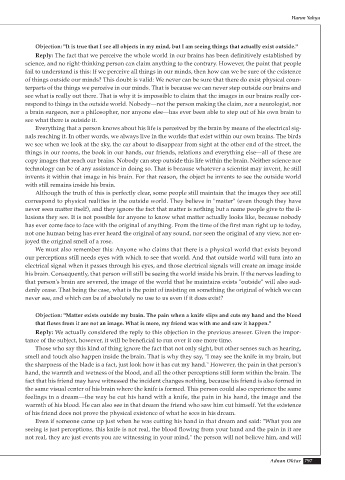Page 799 - Atlas of Creation Volume 3
P. 799
Harun Yahya
Objection: "It is true that I see all objects in my mind, but I am seeing things that actually exist outside."
Reply: The fact that we perceive the whole world in our brains has been definitively established by
science, and no right-thinking person can claim anything to the contrary. However, the point that people
fail to understand is this: If we perceive all things in our minds, then how can we be sure of the existence
of things outside our minds? This doubt is valid: We never can be sure that there do exist physical coun-
terparts of the things we perceive in our minds. That is because we can never step outside our brains and
see what is really out there. That is why it is impossible to claim that the images in our brains really cor-
respond to things in the outside world. Nobody—not the person making the claim, nor a neurologist, nor
a brain surgeon, nor a philosopher, nor anyone else—has ever been able to step out of his own brain to
see what there is outside it.
Everything that a person knows about his life is perceived by the brain by means of the electrical sig-
nals reaching it. In other words, we always live in the worlds that exist within our own brains. The birds
we see when we look at the sky, the car about to disappear from sight at the other end of the street, the
things in our rooms, the book in our hands, our friends, relations and everything else—all of these are
copy images that reach our brains. Nobody can step outside this life within the brain. Neither science nor
technology can be of any assistance in doing so. That is because whatever a scientist may invent, he still
invents it within that image in his brain. For that reason, the object he invents to see the outside world
with still remains inside his brain.
Although the truth of this is perfectly clear, some people still maintain that the images they see still
correspond to physical realities in the outside world. They believe in "matter" (even though they have
never seen matter itself), and they ignore the fact that matter is nothing but a name people give to the il-
lusions they see. It is not possible for anyone to know what matter actually looks like, because nobody
has ever come face to face with the original of anything. From the time of the first man right up to today,
not one human being has ever heard the original of any sound, nor seen the original of any view, nor en-
joyed the original smell of a rose.
We must also remember this: Anyone who claims that there is a physical world that exists beyond
our perceptions still needs eyes with which to see that world. And that outside world will turn into an
electrical signal when it passes through his eyes, and those electrical signals will create an image inside
his brain. Consequently, that person will still be seeing the world inside his brain. If the nerves leading to
that person's brain are severed, the image of the world that he maintains exists "outside" will also sud-
denly cease. That being the case, what is the point of insisting on something the original of which we can
never see, and which can be of absolutely no use to us even if it does exist?
Objection: "Matter exists outside my brain. The pain when a knife slips and cuts my hand and the blood
that flows from it are not an image. What is more, my friend was with me and saw it happen."
Reply: We actually considered the reply to this objection in the previous answer. Given the impor-
tance of the subject, however, it will be beneficial to run over it one more time.
Those who say this kind of thing ignore the fact that not only sight, but other senses such as hearing,
smell and touch also happen inside the brain. That is why they say, "I may see the knife in my brain, but
the sharpness of the blade is a fact, just look how it has cut my hand." However, the pain in that person's
hand, the warmth and wetness of the blood, and all the other perceptions still form within the brain. The
fact that his friend may have witnessed the incident changes nothing, because his friend is also formed in
the same visual center of his brain where the knife is formed. This person could also experience the same
feelings in a dream—the way he cut his hand with a knife, the pain in his hand, the image and the
warmth of his blood. He can also see in that dream the friend who saw him cut himself. Yet the existence
of his friend does not prove the physical existence of what he sees in his dream.
Even if someone came up just when he was cutting his hand in that dream and said: "What you are
seeing is just perceptions, this knife is not real, the blood flowing from your hand and the pain in it are
not real, they are just events you are witnessing in your mind," the person will not believe him, and will
Adnan Oktar 797

